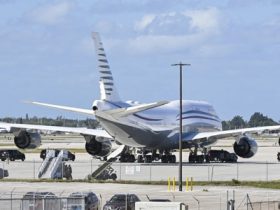Lockheed Martin plans to fold technologies it developed in its unsuccessful bid for the Air Force’s Next Generation Air Dominance platform into the F-35 and F-22 Raptor to create a “supercharged” fifth-generation fighter, company executives said.
Lockheed CEO Jim Taiclet told investors in a Tuesday earnings call the company is not going to challenge the Air Force’s March 21 decision to award the F-47 contract to Boeing. Instead, he said, the company will focus on upgrading the F-35 and F-22 Raptor fighters with sixth-generation technology.
“There are techniques and capabilities … that were developed for [our NGAD bid] that we can now apply here,” Taiclet said. “We’re basically going to take the [F-35′s] chassis and turn it into a Ferrari.”
Taiclet said souping up fifth-generation fighters like this would allow Lockheed to deliver “80% of the capability, potentially, at 50% of the cost per unit aircraft.”
“Eventually, there’ll be 3,500 of those [F-35] chassis out there at various stages of technology and capability [worldwide],” Taiclet said. “We think we can get most of the way to sixth-gen at half the cost.”
Some advanced technologies are already in the works for the F-35′s Block 4 upgrades, he said. Taiclet also pointed to Lockheed Martin’s success using F-35s and F-22s to control autonomous drone wingmen, which the Air Force calls collaborative combat aircraft.
The concept of upgrading one generation of a fighter with technology from the next generation has occurred before, with Boeing’s F-15EX. That jet, the Eagle II, is a modernized version of the fourth-generation F-15, loaded with fifth-generation technologies such as advanced avionics and electronic warfare capabilities.
Taiclet referred to the potential upgraded F-35s as “fifth-generation-plus” — a description reminiscent of the way F-15EXs are sometimes called 4.5-generation aircraft.
The government funded some of the sixth-gen technologies Lockheed has in mind for the F-35 as part of NGAD research, Taiclet said, and Lockheed self-funded others.
Better passive infrared sensors, which could allow the jet to detect enemies at a greater distance without alerting the enemy to your location, was one example of the tech Taiclet said future fighters will need.
In a White House meeting, Taiclet said President Donald Trump declared, “Dogfights are not what we want anymore in air-to-air combat. We want to shoot the other guys before he even knows we’re there.”
Stealth technology developed for Lockheed’s NGAD bid — which include low-observable materials, geometries and countermeasures — could make it even harder for enemy forces to find those jets, Taiclet said.
And sixth-generation-intended tracking technologies and longer-range weapons could also make the F-35 more deadly, he said.
The U.S. government would get the first look at any sixth-gen technologies Lockheed might add to the F-35, Taiclet said. The company also wants to be able to export those technologies to friendly nations that also buy the F-35, he said, but the U.S. would have the final say on what would be exportable.
“Our goal is to make as much of this capability that we can” exportable to allies, Taiclet said. “We try to design [technology] in a way that’s hopefully an easier decision for exportability than a harder one.”
Taiclet said the Air Force debriefed Lockheed Martin on the NGAD decision, and the company is analyzing the service’s feedback. Taiclet would not discuss details on the NGAD debriefing, citing it was classified.
Stephen Losey is the air warfare reporter for Defense News. He previously covered leadership and personnel issues at Air Force Times, and the Pentagon, special operations and air warfare at Military.com. He has traveled to the Middle East to cover U.S. Air Force operations.
Read the full article here








Leave a Reply